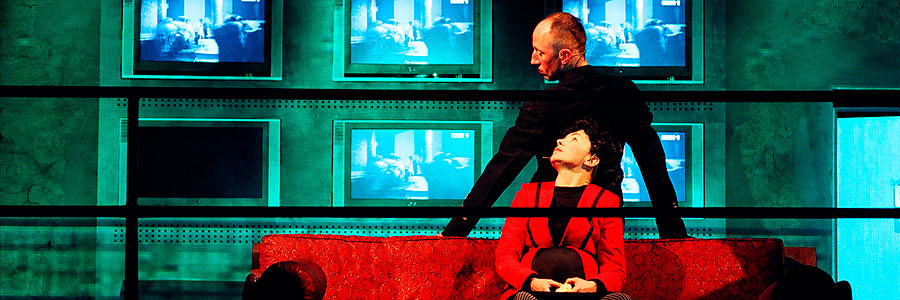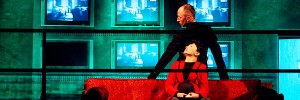
August 13, 2012, by Peter Kirwan
2008: Macbeth (TR Warszawa) @ Guardian Online
By a bizarre quirk of international programming, this is the fourth Polish production of Macbeth I’ve seen. The most recent, by Teatr Piesn Kozla, remains one of the finest Shakespeare productions I’ve ever seen, while Teatro Buiro Podrozy’s Macbeth: Who is that Bloodied Man? created a wild and hugely experimental aesthetic featuring stilts and a rattling death machine. At this year’s Edinburgh Festival, TR Warszawa have been making waves already with their 2008: Macbeth, whose publicity promised a spectacular, contemporary and highly physical theatrical experience. It certainly delivered on gore, nudity, sex and sheer noise, but never quite delivered in terms of insight or heart.
This review is deliberately short as I only viewed the event as a live stream run byThe Guardian, a fantastic notion that opened up an otherwise difficult-to-access production to a much wider audience. However, this large-scale production inevitably suffered on the small screen, with cameras too distant to make out facial expression and occasional interruptions to the service.
The core problems weren’t technical so much as artistic, however. This was a production that threw the kitchen sink at the play at the expense of coherence. A Middle Eastern setting was advertised and initially delivered. A modern Scots aerial army descended, led by Macbeth and Banquo, to blow up and then execute a room of praying Muslims, presumably imagined to be terrorists. Macbeth took one of the bodies and messily cut off its head; an act echoed by Macduff in the aftermath of their own battle, making the non-too-subtle point that what Macbeth had visited on others was being returned on him. Yet elsewhere the Middle Eastern aesthetic entirely disappeared.
Instead, we were left with a mess of images. Duncan, the general, was entertained by Lady Macbeth dressed as a geisha and an Elvis impersonator on his arrival at Macbeth’s place, while Macbeth soliloquised on an outside balcony. The witch initially appeared dressed in burka, but later emerged as a bald, sexualised Doctor who lounged on Macbeth’s couch to deliver her ‘diagnosis’ and then later spontaneously caused Lady Macbeth’s death while the latter emptied a washing machine. The two-layered set suggested multiple levels to a society, but spatially the places of the production collapsed into each other in an incoherent mess. The Witch was accompanied by a conjurer (who performed during Banquo’s offstage murder) and a human rabbit who bounced around in her wake, to no obvious point. The production was advertised as ‘filmic’, but the painfully forced surrealism and attempts to create montage rather smacked of superficiality.
The production’s misogyny was another sore point. In this militarised society, director Grzegorz Jarzyna seemed intent on finding honour and strength in the male characters. Lennox (I think) forced the war-room theorist Malcolm to perform press-ups in order to stop his crying after Duncan’s murder, and the men (often communicating through video phones, with faces projected onto screens or the back wall) adopted the difficult strain of men attempting to overcome extreme adversity. Macbeth was entirely honourable, even explicitly telling his wife that he wanted to take no action, that he wanted peace and that he could only find that with her. Lady Macbeth was obliged to talk Macbeth not only into the murder of Duncan but also into that of Banquo, even faking her own pregnancy in order to get her own way. The production’s rewriting to place the blame on the lady served no purpose, demanding a judgement of her that was conflated uncomfortably with her overt sexuality, particularly in the cheap laughs gained by her kneeling before him and leaning in, only to sweetly tell him his shoelace was untied.
Technology was used to great effect, particularly in the banquet scene where a naked Banquo entered and began rattling the dining table hard, during which the lights dimmed and a roaring soundscape crescendoed as Macbeth screamed in anguish. The witch’s prophecies were projected onto the back wall, her voice magnified to an extraordinary level that ended up shaking the ground on which all of the characters walked. But noise does not equal drama, and the attempts to create high emotion in these ways did the actors a disservice. They were reduced to ranting, shouting, sobbing and laughing hysterically, depriving the play of nuance and instead beating the required effect out of the audience.
This was spectacular theatre, and a fascinating use of technology meant that 2008: Macbeth was never less than entertaining. Yet beneath it lay a deeply conservative reading of the play that failed to say anything meaningful about the political context it appropriated (instead, rather more distastefully, appropriating a recent conflict for its aesthetic value) and preferred to bludgeon rather than explore. There were moments of beauty and genuine effect – Macbeth suddenly shooting the returned murderer in the head, the opening assault on the enemy, the closing hysterical laughter of Macduff and Malcolm as they held up Macbeth’s head. There simply, however, wasn’t enough beneath the surface to hang the special effects on.
No comments yet, fill out a comment to be the first


Leave a Reply